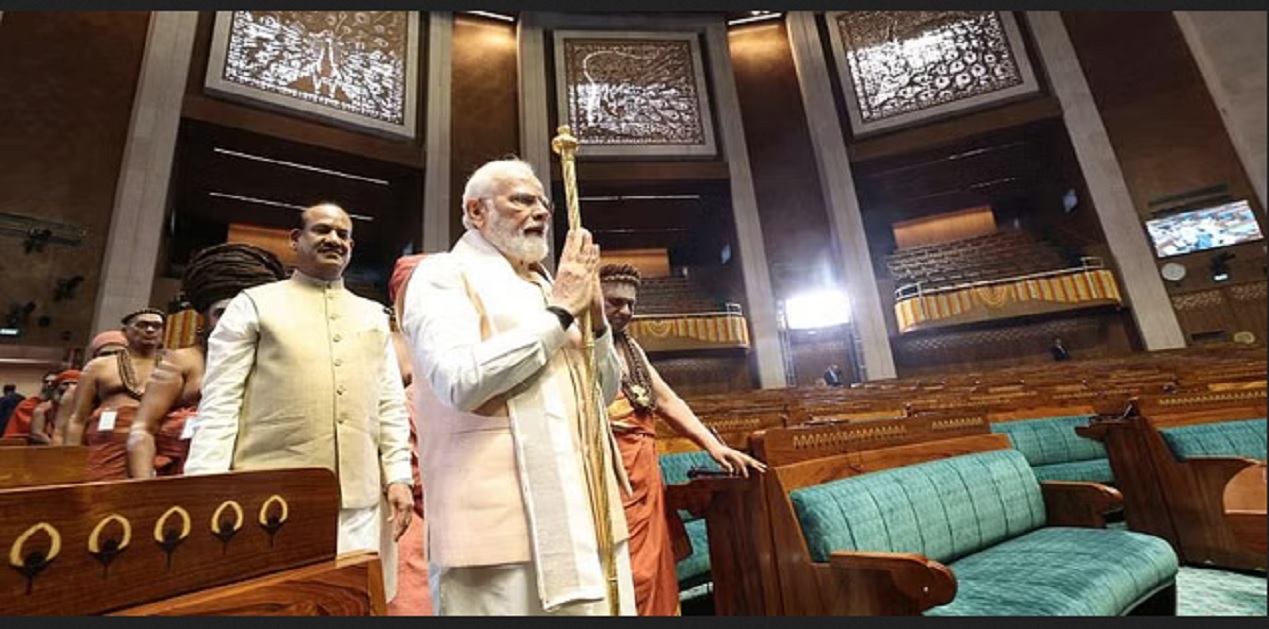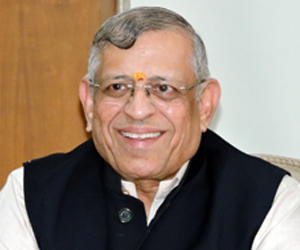But answers to such questions, important as they are, will hardly capture the deeper vision that underlies Modi’s Sengol mission.
Why did Narendra Modi choose to recall the August 14-15, 1947 midnight history of Sengol now?
Why did he time it with the inauguration of the new Parliament building?
Did he hit upon the idea to make the boycott of the parliament building inaugural worthless?
Why did he choose to install the Sengol in Parliament in a pivotal position? Why did he do it on a scale and style that grabbed the nation’s attention for days?
Did Modi convert Rajaji’s choice of a non-Brahmin Tamil Adheenam in 1947 as a political full toss in 2023 to show his respect to a non-Brahmanic ceremony in the grand opening of the new building?
Did he recall the 1947 ceremony to strengthen the bridge between south and north, particularly between Tamil Nadu and Delhi?
When one Adheenam vested the Sengol in 1947, why did Modi invite all Tamil Adheenams to install it in 2023? For the BJP to make inroads into Tamil Nadu?
These and similar questions will continue to be debated.
Modi’s well-thought move
But answers to such questions, important as they are, will hardly capture the deeper vision that underlies Modi’s Sengol mission. He hasn’t ventured into the 1947 Sengol history in a thundering show for immediate political objectives. It might shock many – but not Modi – that Pandit Nehru, who held the Sengol as the symbol of the transfer of power, himself had accepted before Jinnah demanded partition Hindu civilisational Idea of India! Nehru compromised his Hindu civilisational convictions to avoid the partition, but finally, he couldn’t.
But unfortunately, the compromised Idea of India Nehru had accepted to avoid partition became the current Idea of India post-Independence. Modi’s Sengol strategy is a well-thought move to recall the pre-partition Hindu civilisational Idea of India, which the Sengol-bearing Nehru himself had articulated but later compromised. Modi is setting Nehru’s compromised Idea of India today against Nehru’s own pre-partition Hindu civilisational Idea of India. Here a forgotten part of the pre-partition history is inevitable. To start with, the disconnect between the current idea of India and the spirit of the freedom movement.
Disconnected from pre-Independence spirit
No research is needed. Just a few examples will demonstrate that the post-Independence Idea of India is not the same as the pre-Independence Idea of India. Feminist scholar Stephanie Tawa Lama, describing how, in India, the feminine force represented power, said that the entire Indian freedom movement was fought in the name of a woman, Bharatmata. And yet that inspiring symbol of Mother India and ‘Bharat Mata Ki Jai’, the war cry of freedom fighters, turned into political liabilities post-independence. The mystic song Vande Mataram, which inspired the revolutionaries to kiss the gallows and satyagrahis to bear lathi blows and jail life, was reduced into a sectarian verse post-independence. Its core content was edited out to reduce it to a fourth of its original size.
Before Independence, all those who fought for freedom – non-violent satyagrahis or violent revolutionaries, Congressmen, communists, socialists, or Hindu Mahasabaites – were revered as freedom fighters. But post-Independence, they were all given ideological colour; on that basis, they were credited, discredited, respected, or disrespected. Even the civilisational symbols which, post-1947, ornated the calligraphic Constitution of India signed by all Constituent Assembly members — the Vedic Gurukul, the Scene of Rama’s return to Ayodhya, Geethopadesa in Mahabharata, Image of Nataraja, Bhagiratha’s penance and Ganga’s descent, Chhatrapati Shivaji and Guru Gobind Singh – lost legitimacy in secular India. The disconnect from the freedom movement is self-evident.
Modi has obviously zeroed in on and found what has caused the disconnect. In the Sengol symbolism, Modi had seized the opportunity to reconnect his Idea of a New India to the pre-independence Hindu civilisational idea of India – articulated by none other than Nehru himself before Jinnah detonated the partition bomb in 1940. Nehru’s pre-partition Idea of India was founded on Vivekananda’s Idea of India.
Vivekananda’s idea of India
Vivekananda was no ordinary monk. He was a patriotic Hindu monk. Many Indians would know of him. But very few would have read him. Even fewer would know he founded the freedom movement and inspired the freedom fighters. The British police often found his literature in the hands of freedom fighters and even mulled action against the Ramakrishna Math. The tallest Indian freedom fighters have said that Vivekananda was their inspiration.
Mahatma Gandhi said, “Reading Vivekananda has made me love the country a ‘hundred fold’.”
For Jawaharlal Nehru, Vivekananda “was one of the great founders of the national movement, who inspired the freedom fighters.”
Subhash Bose described him as “the spiritual father of the modern nationalist movement.”
Rajaji wrote, but for him, “we would have lost our religion, not have gained our freedom; we owe everything to him.”
Rabindranath Tagore told fellow Indians, “If you want to know India, study Vivekananda.”
Maharishi Aurobindo, Subramanya Bharati and others too were inspired by him.
What was Vivekananda’s idea of India?
“A nation in India,” he declared, “must be a union of those whose hearts beat to the same spiritual tune.”
Did Mahatma Gandhi and Pandit Nehru, who accepted Vivekananda as their inspiration, accept his idea of India as well? Yes, they did.
Nehru, Gandhi, Rajni Palme Dutt – Idea of India
Nehru accepted Vivekananda’s Idea of India explicitly. In his celebrated Glimpses of World History [1935], Nehru wrote, “Vivekananda eloquently and forcefully preached the gospel of nationalism which was not anti-Muslim or anyone, nor was it a narrow nationalism. Nonetheless, his nationalism was Hindu nationalism, and it had its roots in Hindu religion and culture.” [p507] Nehru added, “It is not easy...to draw a line between Hindu nationalism and true nationalism. The two overlap as India is the only home of Hindus, and they form a majority there.’ [p720] Nehru’s Idea of India, before Jinnah rooted for partition, aligned with Vivekananda’s idea of Hindu nationalism.
How many Congressmen, Rahul Gandhi included, would have known this?
But what was Gandhi’s Idea of India?
Most Indians wouldn’t have even heard of Gandhi’s short book Hind Swaraj [1909] - regarded as his Bible – which he stood by even in 1940. It contained an imaginary dialogue between Gandhi, the Editor, and Gandhi, the reader. To a question by the Reader Gandhi, was it not the British who made India into one nation through post offices and railways, Editor Gandhi replied, “We were already one nation, and that was why the British could establish one government. Gandhi admitted that we had differences. But, ‘Our leading men’, he wrote, ‘travelled throughout India; learned one another’s languages; there was no aloofness between them.’”
“‘What could be the intent of our farsighted ancestors who established Setubandha (Rameshwar) in the South, Jagannath in the East, and Hardwar in the North as places of pilgrimage,’ Gandhi asked, and replied, ‘They were no fools. They knew that God could be worshipped just as well at home. They had the Ganges in their own homes. They saw that India was one undivided land so made by nature and argued that it must be one nation. They established holy places in various parts of India and fired the people with an idea of nationality in a manner unknown in other parts of the world. And we Indians are one as no two Englishmen are.”
Both Gandhi and Nehru had almost the same Idea of India. – Nehru’s was religio-cultural, and Gandhi’s was wholly religious. A Marxist, Rajni Palme Dutt, who founded the Communist party in England also ideated India from the Hindu civilisational perspective. Rebutting the colonialists’ claim that their education gave Indians the spirit of freedom, Dutt wrote in his famous work, “India Today” [1940], “If the Indian bourgeoisie had been educated only in Sanskrit Vedas, in monastic seclusion from every other current of thought, they would have assuredly found in the Sanskrit Vedas the inspiring principles and slogans for their struggle” for freedom. A communist for whom looking at the past for the future would be abhorrent argued that the Hindu Vedas would inspire freedom struggle. Even in the revised edition of his book in 1973, he did not change that narrative.
For Gandhi, Nehru, or Rajni Palme Dutt, the Idea of India was rooted in Hindu civilisation.
Point of disconnect – March 24, 1940
That was the national consensus on the Idea of India till 1940. What then disconnected the post-Independent idea of India from the Idea of India common to Gandhi, Nehru, and Dutt? The short answer is – Jinnah’s Partition resolution of March 24, 1940, that India be divided on religious lines. At once, the Congress leadership dropped the Hindu civilisational Idea of India like a hot potato – in a desperate bid to avoid partition, which finally they could not.
They merely ended up compromising on the pre-partition Idea of India, which inspired the freedom movement. Post-Independence Indian rulers did not even attempt to reinstate the Idea of India they had sacrificed to escape the partition. For them, it was easier to extend the compromise that disconnected India from the pre-independence spirit.
The reconnect
Modi, who was often accused of changing the Idea of India, has now got the accusers on the wrong foot. Those who have been accusing Modi of changing the Idea of India are the ones who changed the Hindu civilisational Idea of India common to both Gandhi and Nehru. Looking to reconnect contemporary India to the pre-partition Idea of India, Modi saw the Sengol ceremony of 1947 as a golden opportunity.
He saw the Sengol as a symbol to reconnect with the Hindu civilisational India that Pundit Nehru himself was comfortable with before partition. The picture of Nehru holding the Hindu Sengol icon, Modi thought, is the surest way to reconnect contemporary India to India before March 24, 1940.
Modi’s Sengol mission is no short-term project. As he pushes his mission forward, the nation will witness an explosive debate on the Idea of India – that is long overdue.










Post new comment